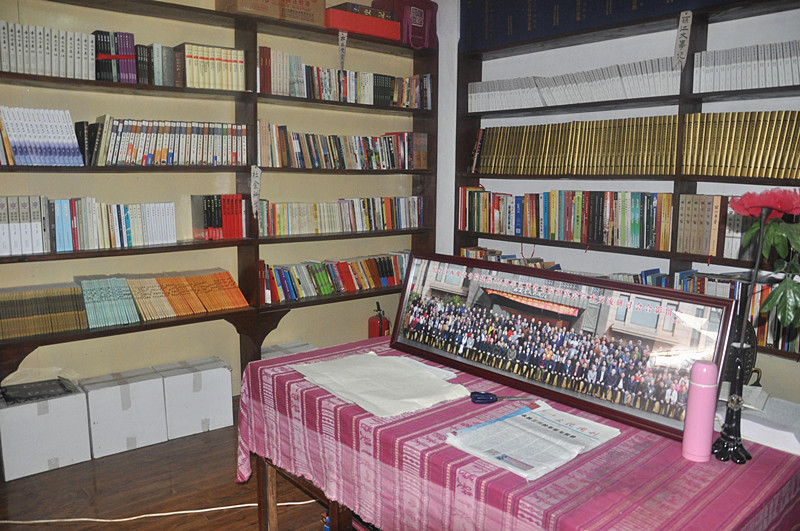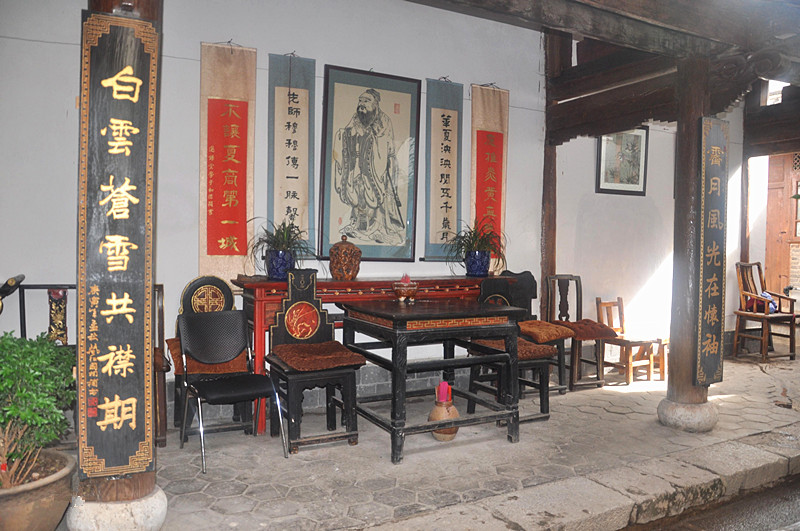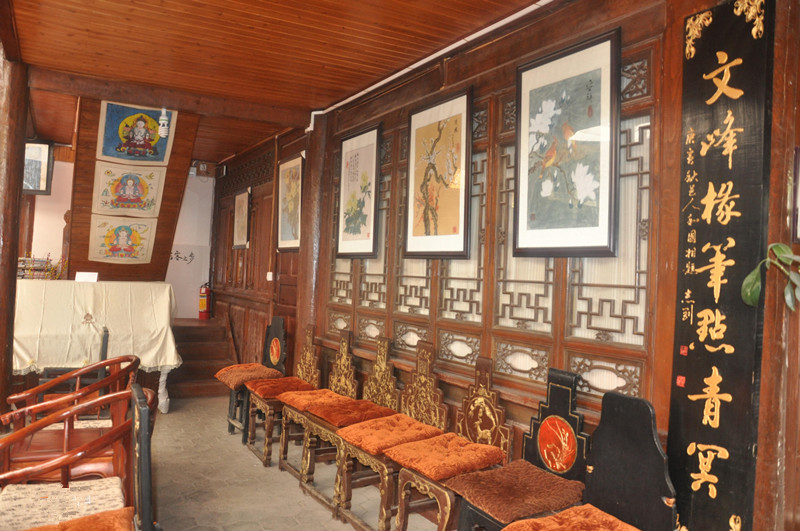Xueshan Academy in Lijiang Old Town
Xueshan Academy (雪山书院), located on Wuyi Street in the Old Town of Lijiang (丽江古城五一街), stands as an important cultural landmark following the “Gaitu Guiliu” (改土归流) reform in Lijiang (丽江). Closely tied to a turning point in Lijiang’s history, the academy’s founding is recorded in two versions—either in the first year of Yongzheng (1723) or the third year (1725). It is widely believed to have been established by the first appointed official magistrate Yang Bin (杨馝), though some accounts suggest it was co-founded with Wan Xianyan (万咸燕), a Confucian scholar in Lijiang Prefecture (丽江府儒学教授).
Construction, Renovation, and Institutional Transformation

Since its founding, Xueshan Academy (雪山书院) underwent several renovations, expansions, and reconstructions. In 1893 (Guangxu 19th year), Magistrate Chen Zonghai (陈宗海), Jinshi scholar He Gengji (和庚吉), and Headmaster Li Fubao (李福宝) initiated a major reconstruction. This expanded the library, made classrooms more spacious, and built a more imposing gatehouse.
In 1905, following the abolition of the imperial examination system, the academy concluded its 180-year educational mission. In 1907, it became the site of the Lijiang Persuasion and Education Office (丽江劝学所), the precursor to the Lijiang Education Bureau during the Republic of China era. That same year, Yunnan’s first vernacular newspaper, the Lijiang Vernacular News (《丽江白话报》), was published here, along with the establishment of the Lijiang Movable Type Printing Office (丽江活字版制造所), marking the birthplace of lead-type movable printing in Yunnan.

After 1912, the academy established multi-level elementary schools but was later severely damaged when it was used as a military garrison. The library’s collection was transferred to the Yuhuangge Library (玉皇阁藏书楼).
Achievements and Educational Influence
Over its 180-year history, Xueshan Academy (雪山书院) made remarkable contributions to education. It nurtured 2 Hanlin scholars, 7 Jinshi (进士), 61 Juren (举人), 12 associate degree holders (副榜), and 154 Gongsheng (贡生), significantly advancing cultural and educational development in the Naxi ethnic region. It also marked the beginning of widespread Han cultural education among Lijiang’s civilian children.

Under the former Tusi (土司) regime, commoners were forbidden from studying for the exams. The academy provided a space where commoner students could study the Confucian classics and pursue official careers. It was the highest institution of Han cultural education in Lijiang and a cultural cradle, forming a key part of the Old Town of Lijiang’s (丽江古城) UNESCO World Heritage designation.
Mission and Educational Philosophy
The academy’s founding mission was “to promote moral transformation through education” in minority-inhabited frontier regions by spreading Confucianism and maintaining regional stability. It also aimed to cultivate talent for the imperial examination. Its guiding principle was: “Morality as foundation, literature as complement” (德为本,文为末).
Library Collection and Legacy
According to the Draft Gazetteer of Lijiang Prefecture during the Guangxu Period (《光绪丽江府志稿》), during its 180 years of operation, the academy collected more than 20 categories of books totaling over 800 volumes. After 1895, gentry and scholars donated extensively, such as He Huchen (和虎臣) who contributed over 3,000 volumes.
In 1919, Lijiang County Library (丽江县图书馆) was established based on the academy’s collection, becoming a major source of public historical books and ancient texts in the region.
Headmasters and Academic Leaders

Historical records show 14 known headmasters and lead lecturers. The first headmaster, Wan Xianyan (万咸燕), was a Jinshi (进士) who compiled A Brief Gazetteer of Lijiang Prefecture (《丽江府志略》), the first officially compiled chronicle of Lijiang. The last headmaster, Li Fubao (李福宝), founded Lijiang’s first higher elementary school, continuing the academy’s legacy.
Academic Environment and Teaching Ethics
Relations between teachers and students at the academy were harmonious, and instruction was rigorous. Teachers such as Yang Nu (杨怒) were known for their strictness, requiring students to recite texts from memory. On festivals like Dragon Boat Festival, Mid-Autumn Festival, and Winter Solstice, students offered “three-color gifts” (三色礼) to express respect, fostering a culture of reverence for education and teachers.
Restoration and Modern Role
On November 7, 2011, Xueshan Academy (雪山书院) was officially restored. Since 2012, it has hosted the Lijiang Forum (丽江讲坛) every Saturday afternoon, covering topics across multiple disciplines and serving as a key platform for disseminating the history and culture of the ancient town.
In 2018, the Lijiang Famous Scholars Forum (丽江古城名家讲坛) was launched, further enriching the cultural mission of the academy. Today, the academy houses over 20,000 books and is being developed into the “Civic Academy of Lijiang Old Town” (丽江古城的镇城之院).

 7 Days GolfingTour
7 Days GolfingTour
 8 Days Group Tour
8 Days Group Tour
 8 Days Yunnan Tour
8 Days Yunnan Tour
 7 Days Shangri La Hiking
7 Days Shangri La Hiking
 11 Days Yunnan Tour
11 Days Yunnan Tour
 6 Days Yuanyang Terraces
6 Days Yuanyang Terraces
 11 Days Yunnan Tour
11 Days Yunnan Tour
 8 Days South Yunnan
8 Days South Yunnan
 7 Days Tea Tour
7 Days Tea Tour
 8 Days Muslim Tour
8 Days Muslim Tour
 12 Days Self-Driving
12 Days Self-Driving
 4 Days Haba Climbing
4 Days Haba Climbing
 Tiger Leaping Gorge
Tiger Leaping Gorge
 Stone Forest
Stone Forest
 Yunnan-Tibet
Yunnan-Tibet
 Hani Rice Terraces
Hani Rice Terraces
 Kunming
Kunming
 Lijiang
Lijiang
 Shangri-la
Shangri-la
 Dali
Dali
 XishuangBanna
XishuangBanna
 Honghe
Honghe
 Kunming
Kunming
 Lijiang
Lijiang
 Shangri-la
Shangri-la
 Yuanyang Rice Terraces
Yuanyang Rice Terraces
 Nujiang
Nujiang
 XishuangBanna
XishuangBanna
 Spring City Golf
Spring City Golf
 Snow Mountain Golf
Snow Mountain Golf
 Stone Mountain Golf
Stone Mountain Golf















